XistentialAngst's Blog, page 75
September 19, 2016
marcespot:
Sherlock crew backstage interview at the Emmys,...
Sherlock crew backstage interview at the Emmys, right after winning Outstanding Television Movie!
September 18, 2016
inevitably-johnlocked:
ambassadoroftjlc:
otp221b:
seducemymind...


The big conclusion of it all: Moriarty’s an actor?
have we been missing obvious clues???????
Okay. I’ll run with it. Moriarty’s an actor hired by whom?
Mary.
Mary or Mycroft. Mary would be the obvious choice. Mycroft if they want to rip our heart out.
@inevitably-johnlocked thoughts?
What about Moriarty himself? There’s some very convincing meta here and here that suggest Moriarty is a twin, and Richard Brook is one half of the two of them. Listen, even Moriarty said the supposed key code was a fake, meaning that THESE RECORDS ACTUALLY EXIST. Richard Brook exists in some capacity (a long long game plan, something he set up?). But then, if he WAS an actor, why didn’t people notice / realize who he was at the trial?
There’s so many unanswered questions here.
I still think Mary is associated in a HUGE way, actually being ABOVE Mycroft (who I think is an unwilling participant in the whole thing) in the chain. I think she has control over when Mycroft’s actions.
But yeah, IF not the twin theory, I think it’s definitely Mycroft who hired him on orders from Mary.
I can definitely see this.
September 17, 2016
Didn't someone say that the day they filmed at the London Aquarium (shark tunnel apparently) they were hiding someone who arrived there in a tinted-window car? And it wasn't Benedict because Benedict was seen? Maybe it was Lars Mikkelsen, who knows?
You are totally right. I had forgotten about that! Thank you for reminding me. So, it’s definitely just as plausible that it was him as anyone. Like I keep saying, we don’t know anything. Those of us in the emp camp are merely trying to make sense of what we have been shown. Thank you for this message. xoxo
@xistentialangst, clearly speculation, but interesting nonetheless.
1895itsallfine:
Yes I disagree with EMP. But you know what I disagree with even more? Being...
Yes I disagree with EMP. But you know what I disagree with even more? Being completely nasty when you happen to disagree with people, willfully mischaracterizing their arguments, and choosing crude, name-calling mockery over dialogue.
(Probably 5% at most of the EMP proponents I’ve seen think it involves all of S3. Most contain it to the very end of HLV. And, no, I don’t personally think even that’s going to happen, for many reasons that I’ve listed out myself, and reblogged from others, but, wow, how wildly disingenuous to try to deride the whole thing by bringing up multiple plot points from TEH and TSOT. Putting aside for the moment the basic choice to be mean to other fans (who are just having fun and afaik haven’t been nasty themselves?) for no good reason, exaggerating only serves to detract from the reasonable arguments others are making against the most prevalent limited-scope theory.)
I’m not sure I’ve seen the post this is referring to, but… I agree.
I’m not 100% convinced of EMP/EDT. However, the main arguments I’ve seen against it don’t address the real reasons it even came into being in the first place. Things like Mycroft’s tie, lines like “None of this is real” (Moriarty in TAB), items mysteriously swapping position (Mycroft’s office), or the backwards running heart monitor. Yeah, the show does weird shit and not everything has to mean something, but when there’s a bunch of stuff like this that appears to have no narrative purpose (without EMP/EDT), it’s interesting to posit ‘what if’ theories as to what it means.
Also, I personally find it disturbing that they have that one ‘modern day’ scene in TAB that is demonstrably false. The writer in me wants to sort of slap them and say ‘keep it clean!’ When messing with something like a jump back in time, you’d think they’d be very clear about what IS imaginary and what ISN’T in order to avoid narrative confusion. The fact that they didn’t do that is a big ‘hum’ moment to me. Since they have already muddied the waters in that way, there must be a reason. Like setting a precedent. They’ve told us it’s not going to be clear, so what else can we not depend on?
I also agree that some of the things pointed to as ‘evidence’ of EMP, such as the scene with Janine in the hospital, aren’t so far out of bounds that they are necessarily false. After all, this show is ultimately about Sherlock’s sexuality/romantic life, so having that bit with Janine focus on absurd lies about his het virility, which John will likely see and be another ‘miscommunication’ factor in the romantic arc, makes total sense to me. The show is pretty whacked really, so very little is truly out of bounds.
However, I’m not sure I’ve seen ANYONE posit that all of S3 and TSoT is MP? So I don't get that counter argument. The most I’ve seen is that it began the moment Sherlock was shot in Magnussen’s office. Personally, I don’t even like that because I feel like the scene where Mary is revealed to John as a villain and the domestic are just too significant and too iconic to be false and then require a complete re-do in S4. But hey, the truth is NONE OF US KNOWS FOR SURE. We’re ultimately just passing gas until S4 airs (no pun intended). So there’s no point in anyone acting like they KNOW the truth or being rude to others. IMHO. Of course, everyone has opinions about what they think is going on and sharing those opinions is what we DO.
As for me, the OOC moments at the end of HLV, such as John forgiving Mary and his weird blankness on the tarmac and on the plane – these could be explained in several ways. If it is ‘reality’, and really happened that way, then I believe John has a plan we’re not seeing. God, I hope so anyway! Because otherwise, I’m truly lost as to what is going on with his character. But I also really like the “John’s Choice” idea by tjlcisthenewsexy, where we are only running through a scenario in Sherlock’s head in which John chooses Mary. I just happen to think that’s a cool set-up as a writer, and because of the Dr. Who connection, I can see Moffatiss actually doing something like this. Does that mean it’s absolutely what’s going on? No. It’s one possible explanation that fits some of the weird MP-pointing hints others have pointed out and could be a really brilliant story arc.
On the ‘anti EMP/EDT’ side, one thing I would have expected to see in S4 if the end of HLV was false is Magnussen. We didn’t get even a whiff of him in setlock. Yeah, it’s possible they hid him well, and they would have HAD to to avoid a huge spoiler, but still… there wasn’t the slightest hint of him being involved and I think I recall reading Lars was busy elsewhere during that time.
As for ‘pro EMP/EDT’ stuff in setlock, I would count the ‘happy trio with baby and dog’ stuff as likely an MP projection, whether that’s related to a longer term EMP or not. Because if that’s real, where did the baby go? It just vanishes after that. Also, all of E2 setlock looked really whacked, with the windows in the street, the mysterious LiR, the spotlighting drones, IV bags at conference tables in the street, the sexy 50′s style nurses, etc. Obviously a bunch of that is MP. Yes, it could be MP unrelated to an EMP theory from the end of HLV. However if the EMP/EDT theory is true, I wouldn’t be surprised if E2 is where it comes to a head. After all, there’s all that medical imagery around Culverton Smith, and Sherlock looking like he’s ‘dying’ during the case. So it would tie in very well with the idea of Sherlock actually being in a hospital, possibly in a coma, imagining it all. That’s exactly the sort of case I’d EXPECT to see in that scenario – one involving medical stuff and increasing signs of the ‘reality’ breaking down. But are there other explanations for it that don’t involve HLV-TAB-EMP? Sure! Sherlock could be hallucinating because Culverton Smith is drugging him and it could have nothing to do with HLV/TAB.
Honestly, at this point, I’m finding a lot of the rehashing rather mentally exhausting actually! I am SO looking forward to S4 airing so we can stop wrestling with the existing data set and see what’s real.
XA
"Mr. Archer, on the count of three, shoot Doctor Watson."
This is the BEST line because it was so weird and unnecessary to identify random CIA henchmen #2 by name
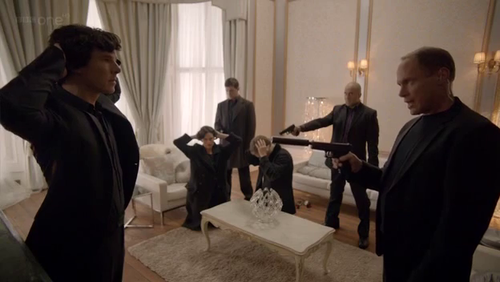
And none of the other CIA dudes ever got named in the dialogue despite being in multiple scenes and, you know, actually having lines
And so for no reason and contrary to all sensible CIA discretion we have an “Archer" instructed to shoot John in this incredibly romance-based episode
An episode where, PS, we’ve already seen background imagery of cupid pointing an arrow in John’s direction

And it’s even better because Arthur Conan Doyle wrote a poem about Cupid that was called The Blind Archer
And the best part is, look at the verses
One whole verse is about cupid the archer shooting a veteran who is a drinker and who CANNOT BELIEVE he’s being shot, it “cannot be right, it’s ludicrous quite” for him to fall in love like this

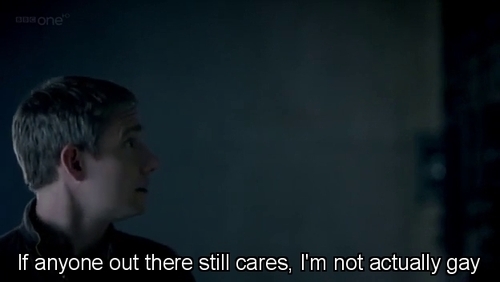
And then another whole verse is about Cupid shooting this isolated young guy who’s planning a celibate vow, despite the fact that he shouldn’t fall in love because “He has duties to do”

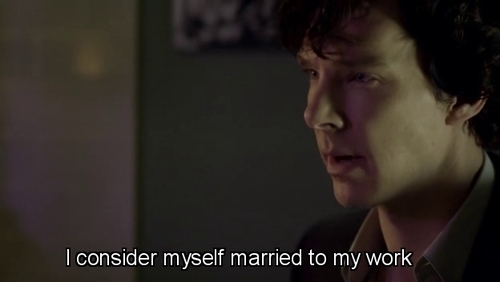
And I just really, really love this throw-away line
And that was the very poem Mofftiss named “The Blind Banker” in tribute to.

And the very Cupid who was meant to open the series.
I never thought about the “Mr. Archer” line but this is brilliant! There is absolutely no reason to name that characters, especially since he never appears again, EXCEPT for some subtext/meta reason. And then… ARCHER? Seriously?
God, I love this show!
deadcatwithaflamethrower:
the-last-hair-bender:
ashermajestywishes:
bearhugsbeerhugs:
neurodivers...
Do I have any followers with ADHD? Or does anyone have some really good information on it? I want to write a character who has ADHD but I don’t know anything about it except the basics so I’m looking to educate myself. Any help beyond a wiki article would appreciated!
Friends, what would you like to see in an ADHD character?
One thing I gleefully identify with is the level of restless frustration experienced by BBC’s Sherlock during boredom (not that Sherlock is necessarily ADHD - let’s not open that diagnostic nightmare of a discussion please!).
I would like to see more of a struggle with internal noise shown in media. Often I see the bouncy, silly outsider view of the disorder and I would greatly appreciate seeing a wider range of symptoms/experiences, including the ones that make us want to pull out our hair. For me, off medication, being in a room where I am required to be silent, still, and focusing is basically my own personal hell.
It doesn’t at all need to be all doom and gloom, just not squirrel-chasing-8-year-old-boy-stereotype so much please!
First of all, philosophium, thanks for asking!
I’m glad ADHD community replied, because they’re a good source of facts about ADHD presented from an ADHD perspective. So, you learn some of what you’d get in a psych textbook, but also what it feels like from the inside.
If you’re really starting from zero, this Buzzfeed article is a nice place to start.
Here’s some miscellaneous information about ADHD that will hopefully help you write more accurate, and less stereotypical, characters.
1) We’re Not All Extraverted, Hyper, Happy Go Lucky Males. We can be male or female, child or adult. I’d love to see an introverted, non-hyperactive ADHD character, ideally a male one. Or an ADHD character who obsessively overthinks, and is prone to anxiety and perfectionism.
2) Look at Both Extremes. In real life, some people with ADHD can only multitask while others can only hyperfocus. Some people with ADHD can focus on the details while ignoring the big picture, others see the big picture brilliantly but miss all the details, while others can bounce back and forth but can’t see both at the same time. Some of us are laid back and prefer to go with the flow, while others react to their disabilities by becoming extremely perfectionistic and trying to plan everything ahead of time (me). Some of us have IQ in the gifted range (see “need for stimulation”), while others have low IQ or severe developmental delays (children who are born prematurely, have lead poisoning, or who have fetal alcohol syndrome often have ADHD). Almost all the people I know with ADHD are artists, scientists, or both.
3) ADHD Is a Disability of Executive Function. Executive function is a confusing mess of tasks performed by the frontal lobe that allow us to control our behavior and respond flexibly and optimally to a changing environment. Some executive functions include working memory, inhibition (i.e., stopping oneself from doing or thinking something), task switching, sustained attention, planning, decision making, prioritizing, prospective memory.
4) We Can Pay Attention, We Just Can’t Regulate It. We can focus for hours on something that interests us, or on procrastinating. We’re not good at focusing on things that we find boring or that don’t matter to us. We also aren’t good at controlling the amount of attention we pay. This is how our attention works:

5) ADHD is a Production Problem, Not a Learning Problem. A lot of us excel at getting information into our brains, especially when it interests us. The difficulty is producing something that shows what we’ve learned by a deadline–be it a paper, a presentation, or a project. For some of us, the hardest part of any assignment is finishing it and turning it in on time in the correct format. If we can do these things, we’ll probably get an A; if we can’t, we’ll probably fail. As a result, the idea of “gradating your effort” doesn’t apply well to us (telling us to “stop being so perfectionistic and do the minimum” makes no sense to us), and our achievement can be all-or-nothing.
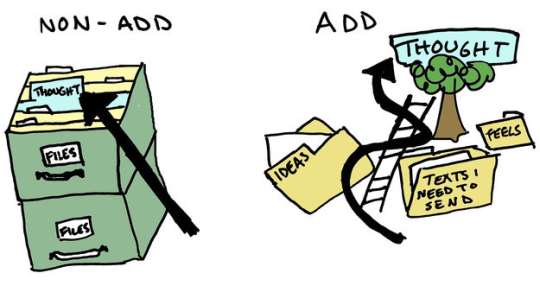
6) We Don’t All Get Bad Grades, Or Misbehave in School. Those of us who are smart, learn easily, and are interested in school can get good grades until the demands for organized, well-formatted, and on-time work overwhelm our abilities to produce (see #5). Those with inattentive ADHD, when bored, tend to daydream, look out the window, or draw rather than misbehave. Teachers might not notice these students at all–or might even see them as well-behaved and a joy to teach.
7) Need for Stimulation. As ADHD community said, an ADHD character who is wildly intelligent, and when bored, feels as if they’re in a sensory deprivation tank. Boredom is Chinese water torture. Each second is a drop of water. How we react to this varies. Some are constantly bored and highly aware of their search for stimulation. Others, like me, think they’re never bored because they’ve become very good at keeping themselves occupied. I always carried a book to read and a sketchbook to draw in with me, and I would read even while crossing the street. Only when I needed to learn to cook did I realize I can get bored within literally 10 seconds.
8) Sometimes, what’s “hard” or “complex” is easy for us, and what’s “easy” or “simple” for others is hard for us. Especially if we’re also gifted. See: http://neurodiversitysci.tumblr.com/post/12568168808/the-complex-is-simple-the-simple-complexif
9) Memory Problems. I’d like to see an ADHD character who has a terrible memory, and struggles with the psychological/identity consequences of that and not just the academic ones. They’re constantly writing things down, and constantly worrying about how to organize the record of their life, or about what would happen if it were destroyed in a fire/flood/other accident. The most impaired form of memory, though, is prospective memory, the ability to remember what you are going to do. Memory problems are some of my worst ADHD traits, yet I rarely see them discussed.
10) Paradoxes of Reminders and Clutters. Because of our memory problems, you might think the answer is simple: just put post-it notes everywhere. And indeed, even other ADHD-ers often advise us to use colorful post-it notes and put them everywhere. However, visual clutter shuts our brains off, so we stop looking at these post it notes and reminders–or even look right at them and don’t register their existence. Another version: if items aren’t visible, I forget that they exist. (For example, I forget about food in the back of the refrigerator until it goes bad; I forget about clothes in the corner of the closet). But if too many things are visible, I stop being able to see them. They just look like clutter, an undifferentiated “bunch of stuff” to me. It would seem like the answer is to get rid of as much stuff as possible, but the decisions involved take hours and leave me exhausted.
11) The Paradox of Routines/Habits: Habits help us function despite our inability to remember what we’re supposed to be doing and our tendency to get sidetracked in the middle. That’s because habits require no thought, attention, or memory–we do them automatically.
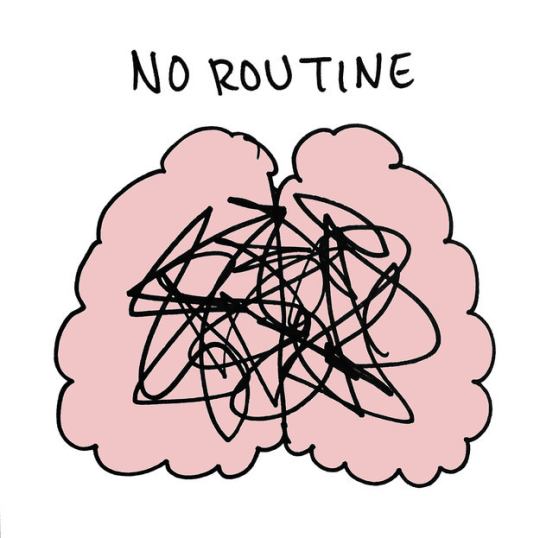

The problem is, it’s almost impossible for us to make the habit in the first place because we can’t consistently remember to do it. So, you get people with ADHD who forget to take their medication for the very reasons they need it in the first place.
12) Inconsistency. An ADHD character whose functioning is inconsistent from day to day and so feels he/she can’t rely on him/herself. There’s a lot of research on this “intra-individual variability” and indeed, it ranks among the most consistently-found traits found in both children and adults.
13) When we’re exhausted or overwhelmed, or a life crisis happens, we can stop being able to do basic things we used to be able to do. Maybe we used to be able to get to work/school on time, remember when assignments were due, or have a consistent morning routine. Now we’re no longer able to get out of the house on time, remember our assignments, or remember to take our medicine or brush our teeth in the morning. When this happens to me, I realize how much energy and attention I’m putting into doing “basic” things and wonder when I’ll ever “get them under control” so I can focus on learning new things.
14) Slow or Inconsistent Processing Speed. We don’t always talk fast and display high energy (I wish!). Some of us struggle with fatigue and slow processing speed (see: Sluggish Cognitive Tempo, a proposed subtype of Inattentive ADHD). For example, I usually feel mentally and emotionally tired–I feel after a full night’s sleep the way most people do after three or four hours of sleep. The more tired I feel, the more difficulty I have concentrating, multitasking, remembering to do things, and making decisions. This is one reason why stimulants and even wakefulness medications can help. Some people, like me, have inconsistent processing speed. Sometimes I think and talk so fast it irritates others, I find what’s happening around us boring (think of the world’s longest meeting), and I interrupt others. Other times, I am just about to answer someone’s question when they irritably repeat themselves or ask why I’m taking so long to answer. It feels like I’m thinking and talking at the normal speed, but others’ reactions make clear that we’re going much faster or slower than they are. Our relative strengths and weaknesses can affect when we think faster vs. slower than normal. For example, I finished the verbal portion of the SAT and checked my answers multiple times halfway through the time limit. I then had to sit there, bored, until the time was up. On the other hand, I ran out of time on the math section before I could check my work.
15) Some of us are socially awkward penguins, not graceful adrenaline junkies. There’s a stereotype that we’re adrenaline junkies who perform surgeries and jump out of planes. Or, we’re social butterflies who compensate for our school difficulties by playing class clown or making friends with everyone. But some of us are physically or socially awkward. Socially, lapses in attention can make us say things that come off as awkward or rude. Our poor sense of timing and inconsistent processing speed can throw off our conversational rhythm, making us interrupt–or just appear odd. Many of us also have motor coordination delays and difficulties (and research bears this out). As kids, we might have had difficulty using scissors, writing, tying our shoes, throwing or catching a ball, or riding a bike. We can have social and/or motor difficulties without meeting criteria for autism spectrum disorder. (Although a lot of people with ADHD have autism, too–see below).
16) Anxiety. Most of us develop anxiety, for all sorts of reasons. We’re prone to overthinking, to begin with. We have to worry about others misunderstanding us and calling us lazy, stupid, flaky, or rude. Some of us develop an exhausting habit of “constant vigilance” because we know of no other way to avoid making ADHD mistakes (losing things, forgetting things, math/writing errors, running late, etc.).
17) Co-occurring conditions. ADHD rarely rides alone. People with ADHD often have dyslexia, math disability, sensory processing disorder, dyspraxia, autism spectrum disorder, depression, anxiety, bipolar disorder, or allergies. Immune system or digestive problems might make us even more inconsistent.
18) Our family members are likely to have ADHD or autism–diagnosed or otherwise. Many people report being diagnosed with ADHD after their own children were diagnosed. Like autism, dyslexia, and other disabilities, ADHD is highly heritable, meaning that it’s highly likely that someone with ADHD traits will have children with the same traits (and their parents probably have them, too). I have a younger brother on the spectrum, and have met a number of other older ADHD sisters with younger autistic brothers. While the gender thing may be a fluke, I have read that ADHD and autism share genetic causes and can run together in families.
19) We have a variety of attitudes towards our ADHD. Some of us see ADHD as uniformly disabling, preventing us from using our talents and passions Other people see ADHD as a gift. People with each of these viewpoints sometimes see the opposite as harmful to people with ADHD. Still others view ADHD as a trait like any other, which can have positive or negative effects depending on how one chooses to use it and what environment one is in. (Personally, I see ADHD, in general, as a set of traits. However, I see mine as mostly negative because they have been impairing me recently and preventing me from pursuing a longstanding dream. I view my ADHD traits as preventing me from using many of my talents and passions. However, there are environments where they’d be less disabling, and I’m currently trying to find them).
20) Being diagnosed and labeled can have good effects, too. There’s a sense of relief, of understanding, of not being broken, of having words for one’s experience. The book title “You mean I’m not lazy, stupid, or crazy?” captures the feeling pretty well, I think. I’ve also written about the benefits of diagnosis and the crappiness of growing up without diagnosis a LOT–see this, this, most of all, this:
“…that sense that there was some mysterious thing wrong with me. (Do you know what it feels like, to carry around a sense that something is wrong with you, always ready to erupt, and not know what’s wrong or why? To have people constantly pointing out when you do something wrong but never acknowledging that mysterious brokenness–pointing out the elephant dung and squished sofa in your living room but never mentioning the elephant or offering to help get it out of your living room? And since no one will talk about the elephant, you have no idea how to get it out of your living room, so you’re just stuck with it there. No one can tell you how to fix what’s broken).”
21) Stimulants don’t necessarily turn you into a zombie. They aren’t necessarily a cure-all, either, and some of us choose not to take them. I have yet to find a medication at a dose I can take daily, because it makes me completely lose my appetite. I only take it during emergencies–high-stakes days where I’m not able to function, and/or due to other health problems acting up, I can’t drink coffee. This isn’t the only side effect. Some people get migraines from stimulants. These medications can also slightly stunt children’s growth.
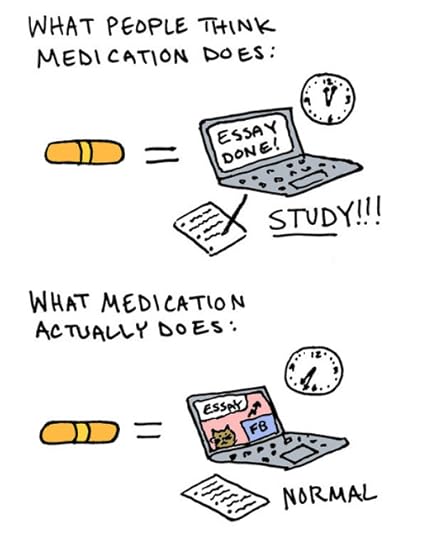
22) ADHD can be seriously disabling. ADHD looks on the surface like something “everyone deals with,” but as the experiences I’ve described above suggest, it can cause serious problems in school, work, and relationships. The large-scale MTA study, which followed hundreds of girls and boys with ADHD into adulthood, found some poor outcomes, including higher rates of self-injury and mental illness; adolescent substance use; eating disorders; and poorer relationships with peers in adolescence and parents and partners in adulthood. ADHD has also been linked to lower test performance, poorer education and work performance, greater risk of accidents, and obesity. Researchers and the media tend to describe these problems as a result of the ADHD traits themselves, especially impulsivity. But the way we treat people with ADHD probably has a lot to do with the bad outcomes. One contributing factor: many, especially those diagnosed late in life, develop crippling shame and self-hatred.
23) We’re also awesome! People with ADHD can be creative, energetic, passionate, thoughtful, academically skilled, empathetic, entrepreneurial, and more. Famous people in every walk of life have diagnosed ADHD, and many past geniuses have traits. Like other disabilities, ADHD colors how we experience and act in the world, but it does not diminish us or make us less human.
24) Bonus point that doesn’t fit anywhere: I’ve noticed that smart women with ADHD have a very distinctive style of talking. We talk fast, crowding as many ideas into a sentence as possible before we forget what we’re saying. We are trying to pack a lot complicated thoughts into a short amount of time. We veer off on tangents whenever someone says something interesting. If two of us start talking, we can go on for hours and never run out of things to say–and also never return to the topic we started with. To those who do not have ADHD, we sound rambling or incoherent. To other women with ADHD, we make perfect sense and the conversation feels exhilarating, with the energy building increasingly as we talk. We sound incoherent to others but not each other because our thoughts are arranged in a very dense and logical web, but we move through the web in a zig-zagging pattern based on associations instead of a straight line. The zig-zag pattern happens in part because with our short working memory, our span of awareness is extremely short. So we operate on associations; everything reminds us of something else. Other people’s words, objects in the room, and music we hear reminds us of something, but then then we forget what we were talking about before. We’re constantly forgetting what we were talking about or what we were doing in the middle. As a result, some of us have a bad habit of interrupting others in order to get our message out before we forget it.
If you have any more questions, feel free to ask! Sorry this was so long…
This list is GOLD
Pure gold
Well……shit. :/
This is one of the best explanatory lists I have EVER seeen.
Reblogging for my own reference. I definitely have some of this shit going on.
September 16, 2016
Still EMP or coma
I just noticed something in HLV in the minute 45’. Please watch when Sherlock supposedly go out of his mind palace. Sherlock is considering Mary and when he come back the monitor behind him, showing us his heartbeat, starts going back and not forward. The monitor is running backwards, from right to left. When he is talking to Janine, in the minute 43'40", the monitor runs well, from left to right.
I don’t know how put the gif from the two scenes so please go and watch and tell me I don’t go crazy.
@monikakrasnorada @isitandwonder @multivariate-madness @stillgosherlocked @gryssenielsen @mylastvowJESUS! YOU ARE RIGHT @yan-yae!!! What a catch!
Folks, watch this, after the Mary-liar-deduction SHERLOCK’S HEART MONITOR RUNS BACKWARDS!Is this the moment? Is this the breaking point between emp and reality? Sorry, I can’t gif that either… please take a look and tell me what you think!
@ebaeschnbliah @monikakrasnorada @stillgosherlocked @the-7-percent-solution
After this moment, I am very sure, all is EMP. God!
Would it be too presumptuous if we called this scene proof for EMP?
What exactly comes before and after this moment? I need to rewatch HLV myself, but I can’t at the moment. Anyone want to break it down?
iamianbrooks:
theonion:
Gay Conversion Therapists Claim Most...

Gay Conversion Therapists Claim Most Patients Fully Straight By The Time They Commit Suicide
Sometimes the Onion writers wake up in the morning and decide they will not be fucking around with anything that day
Love the Onion.
Still EMP or coma
I just noticed something in HLV in the minute 45’. Please watch when Sherlock supposedly go out of his mind palace. Sherlock is considering Mary and when he come back the monitor behind him, showing us his heartbeat, starts going back and not forward. The monitor is running backwards, from right to left. When he is talking to Janine, in the minute 43'40", the monitor runs well, from left to right.
I don’t know how put the gif from the two scenes so please go and watch and tell me I don’t go crazy.
@monikakrasnorada @isitandwonder @multivariate-madness @stillgosherlocked @gryssenielsen @mylastvow
@yan-yae: Wow, great catch! I checked it and you are absolutely right. And you know what? They show us the heart monitor again and again, they are practically rubbing it in. Look, he has a heart monitor, the line is going from left to right as it should. And then, after the Mary deduction when he supposedly comes to, it changes direction. Maybe he never comes out of his MP. Which would mean that thinking about Mary leads him to playing through ideas of how to show John who she is and what she did. Which would explain the boltholes everyone knows about, Mycroft calmly sitting in his office when his brother’s life is in danger, and everything that follows.
They really do rub it in @stillgosherlocked. The amplitude rises when Janine turns the morphine down or when Sherlock moves. And then suddenly in this very short scene after the Mary deduction it runs backwards - it’s a blink and you miss it moment. What’s this scene even needed for? The audience knows that Sherlock is in hospital from the Janine scene. It’s barely 5 sec long. And Sherlock just raises his head. He has even turned his morphine down before. And the scene is followed by John and Lestrade finding his empty room… I’d say the scene is unnecessary exept for the heart monitor. For the way we look at pictures (usually from left to right) the monitor would be the first thing we’d notice when watching this scene. Hell…
@isitandwonder: I just had a short look at the episode. Even before the Janine scene we get at least 10 shots of a heart monitor in the operation theatre. I would say such appliances are shown at least 20 times within a few minutes of footage. They could also have arrows pointing at the heart monitors telling us where to look.
I got you, fams. Bad quality gifs ahoy!
Fowards:

Forwards again:

BACKWARDS:

But oh, what’s this? Doesn’t that whole footage look a bit… reversed? Why yes. Yes it is.

HE’S NOT COMING OUT OF HIS MIND PALACE. HE’S GOING INTO IT.
@yan-yae I AM SCREAMING!!! I’m sorry but I have to say this is fucking me the fuck up! I went back and watched the Janine scene, and I was like, what? Wait. That monitor is doing it’s normal thing, but then. BUT THEN…he ‘supposedly’ comes BACK from his mind palace confrontation of “Mary Watson, who are you?” and the MONITOR IS RUNNING BACKWARDS!!!!! And, then, @doomsteady, you perfect thing, you! You put the gifs here and JUST LOOK AT THAT. Not ONLY is the monitor running backwards, but this entire little scene is the REVERSE of him going into his mind palace!!!!!!!!!!
What does this mean? Which is it? Forwards or backwards??? I’m with @isitandwonder, WHY IS THIS SCENE EVEN HERE???? I keep going on and on about how odd the whole thing is- why is Janine not the worried almost-fiancee? Where are the standard questions we would expect: How are you? What happened? I’m okay, are you okay???? Instead we get absurd and frankly ridiculous tabloid headlines about Sherlock. AND, not even things like: SHERLOCK HOLMES IS A BACK-STABBING MANIPULATIVE BASTARD. No, oh no! We get all these salacious tales of Sherlock being a fucking amazing lay????? SERIOUSLY??? I mean, Sherlock seems like he’d be an attentive lover, imo. He seems to be a very sensuous person but, ahem. He’s GAY. Right?? That entire scene is so over the top and unreal. But now, this added in to the mix?? I’m flailing!!!!!!
@tjlcisthenewsexy @ebaeschnbliah @stillgosherlocked @multivariate-madness
@monikakrasnorada: All this! And every, really everything that comes after is surreal. Lestrade filming a drugged up Sherlock at Irene’s, anytime. Filming a drugged up Sherlock who nearly died, nope. This is just what Sherlock imagines people do (based on past evidence). And this is just the beginning.
What a brilliant development!
Wow. Mind blown. I’m going to have to watch this again when I get the time. Meanwhile, I bow to the Tumblr meta gods.
XistentialAngst's Blog
- XistentialAngst's profile
- 15 followers







